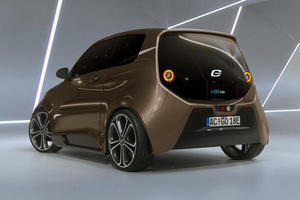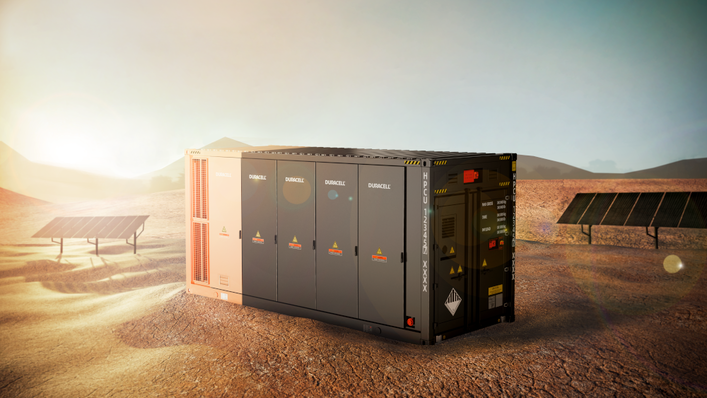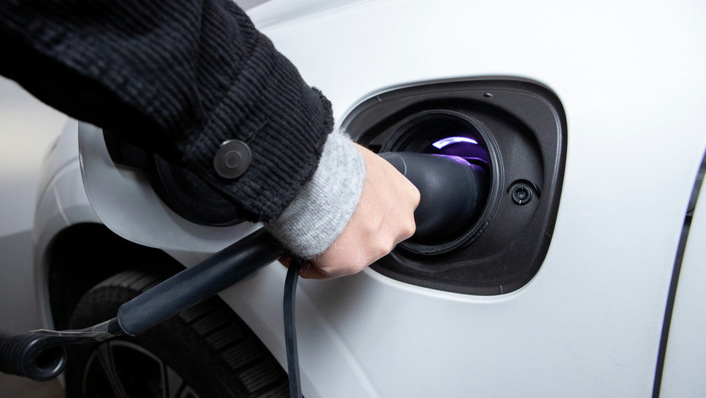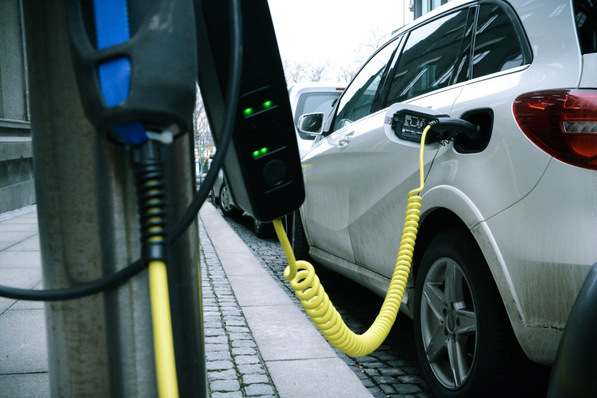The factory floor at the installing company Priogo on the eastern edge of Zülpich in North Rhine Westphalia was quite crowded on July 1st of this year. They were celebrating their tenth anniversary. But that alone would not have lured so many people out here. “We read in the papers that these new EVs were going to be presented here,” Mr Adrien, here together with his wife, says. “We were originally going to wait a little until we got involved in this, but this car is so cheap that it makes sense in any case. What a great price!”
Some years ago, Mr and Ms Adrien had commissioned Priogo to put a solar array on their roof: 7.5 kilowatts. Their children are out of the house and Mr Adrien has a daily commute to Bonn, where he is a public servant. “We are having a charge point installed there,” he remarks. “That way I can charge the car during the day when I am at work, drive it home and then plug it in again in my garage.”
Signed the order immediately
Mr and Ms Adrien signed immediately, even though all they were able to test drive at the company party was a prototype of the new e.GO. The first actual cars will not be delivered until mid-2018. On this day in July, Priogo sold 20 e.GOs. “We have been on the lookout for decent EVs for a while,” company director David Muggli says. “The e.GO is not just a remarkably inexpensive e-car, but also very smart. We were quite won over by their basic concept as well as by the fact that we were able to market this car independently of the major automakers.”
The e.GO is a small and very sleek four-seater which has been developed and is being produced in Aachen. It comes from the manufacturing works of Professor Günther Schuh, where the Street Scooter for the Deutsche Post/DHL has already been developed. They now build 25,000 fully electric Street Scooters per year and the Deutsche Post has taken over the entire company. Subsequently, Bosch also got involved and they have now developed a vehicle for private customers and company fleets – both a city car and for the daily commute.

Up to 170 kilometres of range
With six battery packs (14.4 kilowatt hours) the e.GO has a range of about 130 kilometres, and about 170 kilometres with eight packs (19.2 kilowatt hours). The charging capacity is up to 22 kilowatts. Now for the price: about 15,900 euros. Subtracting the premium for electric vehicles (4,000 euros) and VAT leaves just under 10,000 euros. Mr and Ms Adrien did not hesitate for a second.
David Muggli and his business partner Sebastian Poensgen are major advocates for integrated energy in the Rhineland. “We offer electricity, heating and as of recently also mobility under one roof,” Poensgen explains. “I personally drive a Renault Zoe – about 24,000 kilometres per year – two thirds of which I charge using solar power from my own roof. The e.GO will make integrated energy perfect.”
Especially lucrative for commuters
In addition to solar panels, inverters, storage and cogeneration units, these new EVs open up a further group of products that an installing company can entice their customers with. Combustion engine cars waste a considerable chunk of their customers’ monthly budget: petrol, vehicle tax, inspections, MOT, emissions tests, repairs.
This quickly adds up to hundreds of euros, also and particularly for commuters. Even if the guaranteed commuter allowance is a hidden subsidy (journeys to and from work can be offset against tax), about three quarters of all the miles driven in Germany are commutes of under 80 kilometres per trip.
With an EV, the actual costs for commuters come down significantly. The cost for petrol – or the cost for solar power in this case – are reduced to 25 to 20 percent. Emissions tests do not apply, the same is true for the vehicle tax. Inspections are almost unnecessary, wear on the vehicle is much less: An EV has very few moving parts or parts that become hot. “A BMW 5-series has about 150 moving parts,” Professor Günther Schuh from Aachen demonstrates. “The e.GO has a dozen at most.”
An electric motor made by Bosch
The break disks are also less under strain than with conventional cars. As an EV decelerates, the electric motor acts as a generator. It pushes the energy back to the battery in the form of electricity. This is called regenerative breaking. For Teslas experience as shown that the tyres wear off faster. “The e.GO is powered by a strong starter motor by Bosch that runs on 48 volts,” Schuh explains. “It will leave behind any Porsche at the traffic lights. And it stays ahead if the next lights are close enough.”
The Aachen-based engineers have demonstrated with their Street Scooter that they know what they are on about. Developing cars for private customers is one side of the coin. The challenge is in sales. For the Street Scooter, the Deutsche Post took over the entire factory. The e.GOs on the other hand have to be sold piece by piece. Marketing and global sales at volume – this is the actual core business of the major automakers. Now this underdog from the outer western fringes of Germany comes along to disrupt the whole thing. And that is why now is the time for the installing companies to get involved in selling the e.GO.
Car dealerships are dying out
To be able to establish car sales as another string to the bow of an installing company, it is important to know one’s way around this sector. Germany currently has about 7,000 car dealerships. At the beginning of the century, there still were 18,000. Pressure on the dealers is massive, and there is the process of consolidation. Experts predict that in 2020 there will likely be just 4,500 dealers left. Reasons are shrinking margins and rising costs.
Basically, car dealerships are faring just like corner shops: Small, family-run dealerships are increasingly being displaced by large chain establishments. Carmakers on the other hand prefer large dealerships because that allows them to further push down profit margins and sell in larger volumes. These days, banks have almost completely withdrawn from financing car dealerships.
It is the associated garage that usually makes the money. That is why the number of authorised and independent repair shops in Germany has been coming down fairly slowly. In 2016, Germany still had 16,800 brand-name garages and 20,940 independent car mechanics. Only because a conventional combustion engine car requires so much maintenance, this market was able to stay afloat.
Little need for a garage
For an EV there is little need for a garage, or at least it is limited to a few parts: headlights, panels, windows, mirrors, tyres. As opposed to a VW Golf, the e.GO has a chassis where the outer parts have no structural function. Back when they designed the Beetle, VW had actually invented the subframe. This concept was then developed further by Formula 1, where it is known as a monocoque: “We treat the occupants and the battery like raw eggs,” Professor Schuh explains. “The battery is built into an aluminium shell made from square tubing that is rigid enough to hold the chassis together. The outer shell does not have to bear any loads.”
That saves on expensive pressing tools. “Instead of 100 million euros, our tool set is only 500,000 euros,” production expert Günther Schuh explains. Because both the drive technology and the entertainment system are made by Bosch, they also offer the customer service for the e.GO.
That means that this car can be serviced right from the start in any point of a nation-wide network of service stations – just in case something rattles or is dented. This in turn makes sales easier for the installing company. After all, the question of servicing is usually the first issue that comes up.
Tom & Jerry in Zülpich
The new e.GO from Aachen is currently undergoing final tests. In Zülpich, Professor Schuh and his team were presenting the two prototypes ‘Tom’ and ‘Jerry’. 50 cars will have been built by the end of 2017, in order to conduct further beta tests. The factory in Aachen will be established by April 2018 and during that year 1,000 cars are to roll off the assembly line. Starting in 2019, annual production is to rise to 10,000. “That means a new e.GO will come off the assembly line every ten minutes,” Professor Schuh promises.
One thousand units, the entire planned volume for 2018, have already been sold. Priogo secured 100, 30 of which they have also sold already. This does not make David Muggli and Sebastian Poensgen ‘circulators’ of these cars, as in the case of importers of Chinese EVs. They provide information and advice to their customers, while the actual sales contract is made directly with e.GO Mobile AG in Aachen.
The installing company is paid a commission for making the connection and gets to install the solar array on the customer’s roof and a charge point in his garage. And maybe a stationary storage battery to act as a buffer during the night in his basement. It could also be possible to combine the EV with a cogeneration unit. This technology is also highly subsidised (KfW programme 433). This will truly make the solar customer self-sufficient.
Solar power to go
Priogo offers the e.GO together with the Senec.Cloud from the Leipzig-based supplier of solar storage batteries. The Senec.Cloud to Go allows the remote use of self-generated solar power or of solar electricity from any distant installation via 45,000 charging stations all over Europe. “That is not a problem,” David Muggli says. “That is how far we have already come.” And so he trained his sales staff to now (also) sell EVs. “When, if not now, should we get into this?”
Head of sales Philip Müller for e.GO Mobile reveals that there will also be a leasing scheme for the e.GO – at less than 50 euros a month. Key factor in the leasing sector is the residual value of the car. The e.GO currently runs on Samsung lithium cells. The manufacturer gives a warranty of 1,500 charge cycles. “The batteries last between 2,000 and 3,000 cycles. They should be exchanged after seven years,” Professor Schuh says. “At that point the batteries still have 70 to 80 percent of their capacity.” Experience with Tesla has shown that EVs tend to have a significantly higher residual value than comparable fossil-fuel cars – given that they have not been in accidents.
EVs in the Golden City
On the other side of Europe, in Prague aka the Golden City, is Tomas Bilek who has been involved with PV and solar batteries for years. After a short first blooming, the Czech market quickly faded again. Now Bilek has added the eAixam to his product portfolio, which can also be ordered via the Internet. “This is a small electric runabout that is produced in Aix-en-Provence in France,” he says. “The lithium iron phosphate battery has an effective capacity of six kilowatt hours. It can be charged with alternating current. Because the car is limited to 45 kilometres per hour, it is treated as a moped here. I personally use it in Prague traffic and I think it is really cool!”
Prices start at just under 14,000 euros and the EV is licenced for the EU. The range is 100 kilometres. Bilek has been involved in electric vehicles since 2014. At first he rented out Tesla cars and provided customer service to Tesla customers. Tesla so far does not have a branch office in Czechia. “As a result, one of our employees ended up transferring to Tesla headquarters,” he says. “We then started selling charging cables and charge point along with the cars.”
Close cooperation with Fenecon
Tomas Bilek is one of the pioneers of electric mobility in Czechia and Slovakia. He also sells and installs stationary storage units, all the while closely cooperating with the storage specialists of Fenecon in Deggendorf. “We now cover everything from small private residences to commercial-scale installations including primary balancing power,” he says. “Because there currently is substantial support for renewables involving storage technology, our market is growing very quickly.”
Bilek is a forerunner for our south-eastern neighbours in this young sector. He is a founder of the Czech Association for Energy Storage and the Association for Electric Mobility. For him, PV is also the linchpin around which everything turns: It generates the electricity his (mobile) customers use. (Heiko Schwarzburger)
Read more about energy storage
Stay informed, get our free newsletter, twice a week. Register here.
More useful information:
https://www.pveurope.eu/solar-modules/charge-your-electric-car-940-volts-bi-facial-solar-cells







